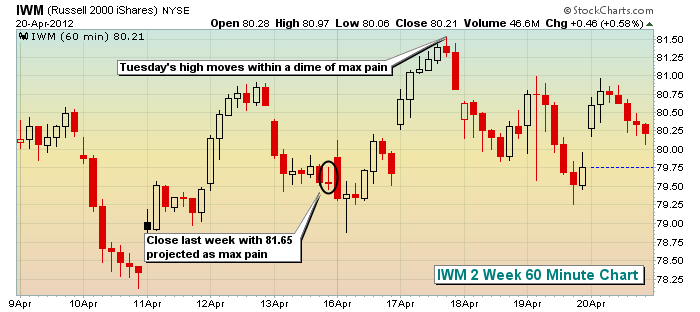Once a month, the stock market provides us a unique opportunity. In basketball terms, it's like the market makers have the ball with time running out in the quarter - or the game - and they nearly always bury that critical three-pointer. For those more predisposed to hockey, think about the "empty net" goal to close out the game. That's probably more fitting because the retail trader is mostly defenseless as the market puck sails into the net.
Options expire the third Friday of every month. It's a day of reckoning for options traders. When the option trader buys or sells contracts, think for a minute who's on the other side of the trade. With the most fluidly traded options, it can be the retail trader on both sides of the trade. But many stocks don't have the kind of contract volume on a daily basis that's necessary to match up retail buyers and sellers and you see "open interest" build.
Enter the market maker.
Let's assume you buy 10 calls on ABC stock and the market maker sells you those calls. To appropriately manage risk, that market maker can then turn around and buy 1000 shares (10 calls represent 1000 shares as each call gives the purchaser the option to buy 100 shares at some future point at a fixed strike price). It's a familiar covered call strategy. Therefore, if ABC continues rising, the market maker is protected as they own the stock.
But think about what happens if ABC moves higher for a period of time and builds a lot of net in-the-money call premium, then reverses suddenly (and, in many cases, temporarily). The market maker owns 1000 shares, so they can potentially benefit from the gain leading up to options expiration Friday. What if that market maker sells their long position, then begins to short ABC as options expiration Friday approaches? They effectively close out their long position with a gain no doubt. Then as ABC mysteriously falls, market makers make money again on their new short position. As ABC falls during options expiration week, what happens to all of the net in-the-money call premium? It vanishes as the market maker rings the cash register again.
It's an empty net goal. Game over.
Every month, the week before options expiration, I calculate "max pain" for the SPY, QQQ and IWM. I define max pain as the point at which in-the-money call premium EQUALS in-the-money put premium. It's the market makers' version of the "perfect storm". Once I calculate max pain, I do NOT look for the major indices to reach the level of max pain. Instead, I simply use max pain as a directional indicator as I would the MACD. It's a part of my overall strategy, not my entire strategy. Last week, for instance, the SPY and QQQ showed a max pain level very close to its then current price. The IWM, however, traded at $79.54 with a max pain level of $81.65. Tuesday's high on the IWM was $81.55. Check it out:
There was net in-the-money put interest, which suggested that IWM (small caps) would have a gravitational pull higher in the very near-term. In order to benefit from this potential move, you could trade the IWM or find individual stock alternatives with a similarly skewed net option interest on the put side.
On Thursday, April 26th, I will be hosting the latest in our Online Trading Series, "Profiting from Max Pain". For details, CLICK HERE
Happy Trading!

